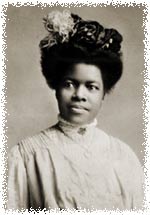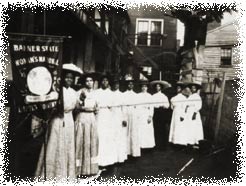
Home
|
|||
| In 1975, Mayor Walter E. Washington proclaimed May 10 to be Nannie Helen Burroughs Day in the District of Columbia–a fitting tribute to a remarkable woman who enriched the lives of all she served. |
Mary Church Terrell
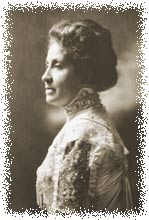 I
was born on September 26,1863 in Memphis, Tennessee. My father,
a self-educated former slave, became a millionaire investing in
real estate. When I was six years old my parents sent me to the
Antioch College Model School in Yellow Springs, Ohio for my elementary
and secondary education.
I
was born on September 26,1863 in Memphis, Tennessee. My father,
a self-educated former slave, became a millionaire investing in
real estate. When I was six years old my parents sent me to the
Antioch College Model School in Yellow Springs, Ohio for my elementary
and secondary education.
I then enrolled in nearby Oberlin College, where I received a Bachelor's degree in 1884. In 1887 I moved to Washington, D.C. to teach at the M Street High School. After receiving a Master's degree from Oberlin in 1888, I toured Europe to study languages.
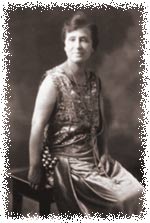 I
returned from abroad in 1891 to marry Robert Terrell, my supervisor
at the M Street High School. Robert later became the first Black
Judge of the District of Columbia Municipal Court.
I
returned from abroad in 1891 to marry Robert Terrell, my supervisor
at the M Street High School. Robert later became the first Black
Judge of the District of Columbia Municipal Court.
In the late nineteenth century thousands of African Americans in the rural South, many poor and uneducated, began to move to cities across the country seeking opportunities. In response to this mass migration educated middle-class African American women in cities organized service-oriented clubs dedicated to racial advancement.
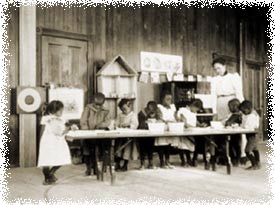 In
1892 I founded the Colored Woman's League of Washington, D.C., one
of the first black women's clubs. Comprised primarily of teachers,
the Colored Woman's League focused on the educational development
of disadvantaged African American women and children. The League
established an evening classes for adults, a program to train kindergarten
teachers, and a free kindergarten and day nursery for the children
of working mothers.
In
1892 I founded the Colored Woman's League of Washington, D.C., one
of the first black women's clubs. Comprised primarily of teachers,
the Colored Woman's League focused on the educational development
of disadvantaged African American women and children. The League
established an evening classes for adults, a program to train kindergarten
teachers, and a free kindergarten and day nursery for the children
of working mothers.
The League started a training program and a kindergarten before these were incorporated in the Washington public school system.
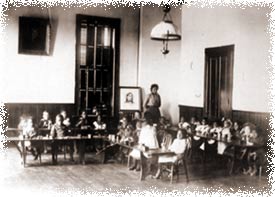 The
success of the League's educational initiatives led to my appointment
to the District of Columbia Board of Education in 1895. I was the
first Black woman in the United States to serve in this type of
position.
The
success of the League's educational initiatives led to my appointment
to the District of Columbia Board of Education in 1895. I was the
first Black woman in the United States to serve in this type of
position.
In 1896 I became the founder and first president of the National Association of Colored Women, a national organization of black women's clubs. Working through this and other organizations I tried to promote the welfare of my race and the empowerment of Black women.
Resources for Teachers:
American Anthropologist. Vol.1 "Games of Washington Children." July 1888. Pages 243-284.
Bicknell, Grace Vawter. The Inhabited Alleys of Washington, D.C. Committee on Housing, Woman's Welfare Department, 1912
Borchert, James. Alley Life in Washington: Family, Community, Religion, and Folklife in the City, 1850-1970. Chicago, IL and London, England: University of Illinois Press, 1980
Easter, Opal V. Nannie Helen Burroughs. Garland Publishing, Inc., New York & London, 1995
Frankel, Godfrey. In the Alleys, Kids in the Shadow of The Capital. Washington, D.C. and London, England: Smithsonian Institution Press, 1995
Green, Constance McLaughlin. The Secret City; A History of Race
Relations in the Nation's Capitol. Princeton, N.J., Princeton
University Press, 1967. xv, 389 p. illus., ports. 23 cm.
Ibid. Washington. Princeton, N.J., Princeton University Press,
1962-63. 2 v. illus. 25 cm.
House of Representatives, Sixty-Third Congress, Second Session on H.R. 13219. Hearing Before the Committee on the District of Columbia. Certain Alleys in the District of Columbia. Government Printing Office, 1914
Johnston, Allan. Surviving Freedom, The Black Community of Washington, D.C. 1860-1880. New York and London: Garland Publishing, Inc, 1993
Jones, Dr. Thomas Jesse. Directory of the Inhabited Alleys of Washington D.C. Printed Through the Generosity of Mrs. Medill McCormick, Mrs. William Belden Noble and Mrs. John Van Schaick, Jr., 1912
The Junior League of The City of Washington. The City of Washington. New York: Alfred A. Knopf, Inc., 1997
Library of Congress. The Learning Page <http://memory.loc.gov/ammem/ndlpedu/>.
Library of Congress. Discovering Hidden Washington Home Page <http://www.loc.gov/kidslc/>.
Sluby, Paul E. Jr. Rosemont Cemetery. Washington, D.C.: Columbian Harmony Society, 1993
Subcommittee of the Committee on the District of Columbia, United States Senate, Sixty-Third Congress, Second Session on Senate Bills 1624, 2376, 2397, 2580, 4529, and 4672. Inhabited Alleys in the District of Columbia and Housing of Unskilled Workingmen. Government Print Office, 1914.
| The
Library of Congress Virtual
Programs and Services |
Contact Us |
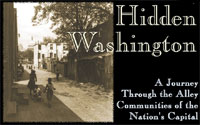 HIDDEN
WASHINGTON: A Journey Through the Alley Communities of the Nation's
Capital
HIDDEN
WASHINGTON: A Journey Through the Alley Communities of the Nation's
Capital
